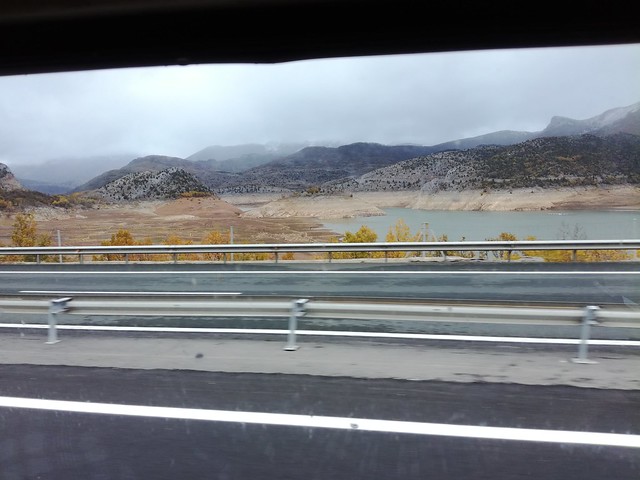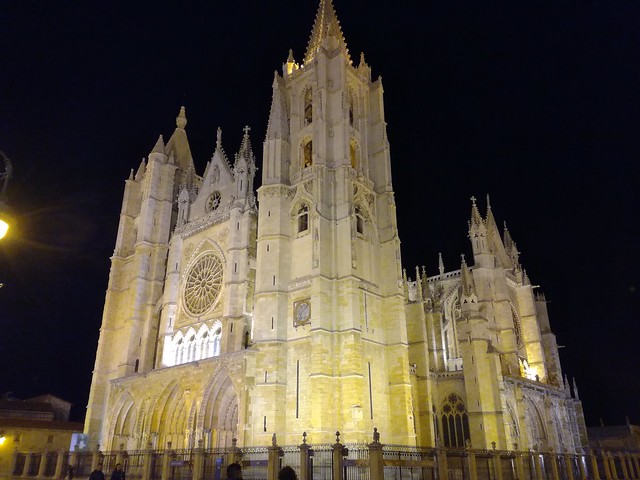Asturias to Leòn
There are two choices going South from Belmonte. The direct route would take us along the windy roads all the way through Parco Somiedo and through a high pass towards Leòn. I was looking forward to that route – three years ago, we went swimming high up there in the lakes and saw some wolves, but one look at the fresh snow on the mountain peaks deters us from this idea, so we take the low road, onto the motorway via Oviedo.
Emma valiantly chugs her way up the mountains until we arrive in the high plateau. We pass a huge reservoir that is almost completely empty. Pepe and Ben Hur had been speaking about climate change and that Spain has not had enough water for the last three years, resulting in water restrictions being imposed by the council even in this green part of Spain. We’d seen a note in a shop window announcing that water may be turned off in the evenings until further notice and that people should economise with water. The empty reservoir is a shocking visual reminder of this (although later someone tells us – while hinting at some story of political corruption – that there is a leak in the reservoir and the water has been let out to repair the leak).
As the land levels out, so the vegetation changes and we enter a very dry, arid landscape. It is hard to comprehend that there are farmers here who would stay put and fight the climate when only 30km further north everything is green and luscious. After a while of musing on the hardships of caring for the land in hostile conditions, we reach the charming city of Leòn.
Our experience of navigating new areas, especially entering cities and finding a place to park, has completely been transformed since having access to the internet on our phones. I use a combination of Google Maps and Park 4 Night to steer us safely to a quiet car park within spitting distance of the cathedral and we wander off to explore the city centre in the fading daylight.
Leòn is beautiful, old houses, interesting architecture, vibrant streets, and judging by the type of shops, it is a rich town. This is a surprising contrast to the deserted and very poor looking landscape we’d passed on our way.
The next morning, we take the bikes to further explore the nooks and crannies of this lovely city. In a shoe shop, I buy myself a solid pair of hiking boots and we taste a Léonnese Empañada. Then it is time to go to Casa Botines, a house built by Antoni Gaudí, for a guided tour in English, just for the two of us!
Though outwardly not a striking as some of his other buildings, the inside of Casa Botines bears all the hallmarks of a Gaudí design. It was built for two textile merchants, who, looking at the location of the station in relation to the old city centre, took an intelligent guess to place themselves in the middle of what was to become the new centre of the city. Gaudí brought along his team of workers from Barcelona (much to the dismay of the local building trade), and within ten months he built this enormous house, containing a textile factory in the basement, a shop on the ground floor, two large flats for the owners on the first floor, then two floors for rental apartments and a flat for the concierge in the roof.
Having gone through a number of incarnations, including being a bank, the house now is maintained by a foundation. Most of the windows (and there are 365, one for each day) are still the original Gaudi design, and so are many of the doors, staircases and banisters etc: There must have been considerable friction with the locals when Gaudi insisted upon putting the statue of George and the Dragon, the Patron Saint of Barcelona, over the main entrance….
A few decades ago, the statue had deteriorated too much and needed replacing and the old argument rose once more, and yet again, posthumously, Gaudi won, and a cast was made of the original. When they took the old one off, they found inside it a led pipe, containing the original plans of the building drawn and signed by Gaudi. These are the only 2-D plans of any of Gaudi’s buildings – he preferred to work with 3-D representations during the process of designing a building. I think he would have really enjoyed using modern computers 
Here’s me hobnobbing with the artist 
For more photos of this chapter, including some shots of Gaudi’s beautiful, ergonomically designed furniture, click here
Posted in Uncategorizedwith comments disabled.


